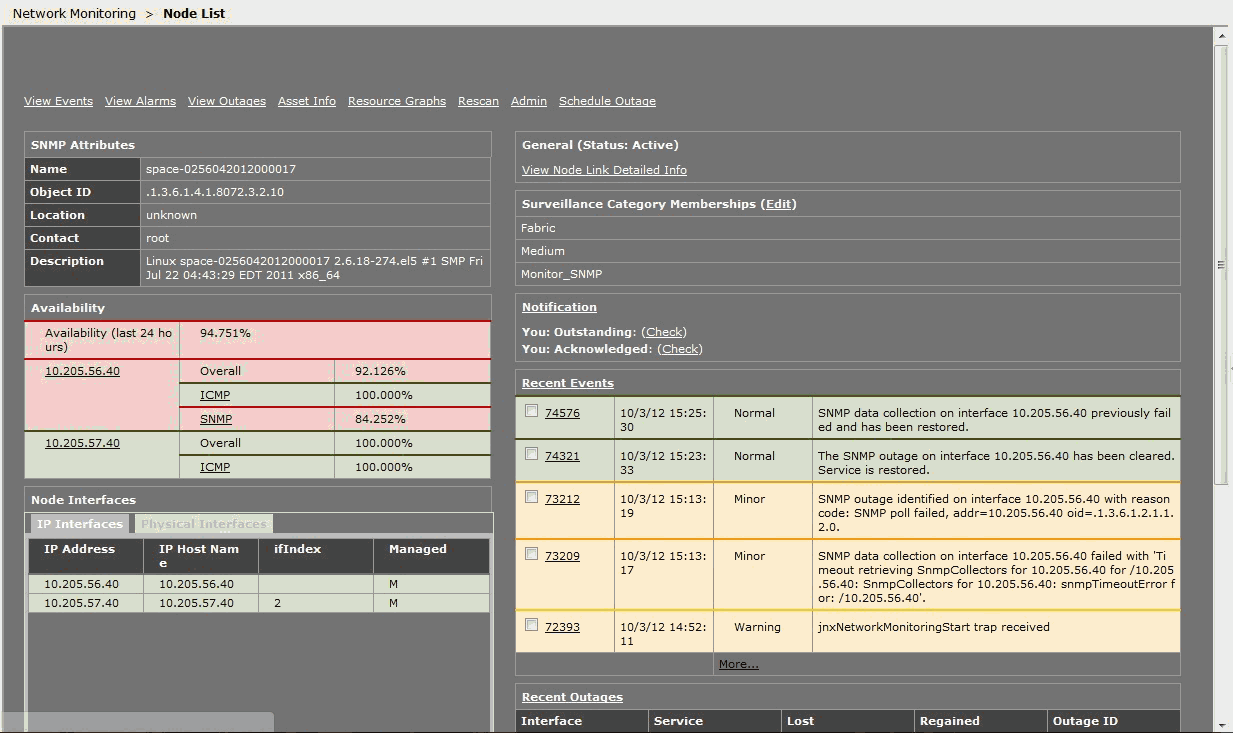- play_arrow Overview
- play_arrow Introduction
-
- play_arrow Devices
- play_arrow Device Management
- play_arrow Systems of Record
- play_arrow Device Discovery Profiles
- play_arrow Modeling Devices
- Rapid Deployment Overview
- Zero Touch Deployment Using Autoinstallation and Junos Space Network Management Platform on ACX Series and SRX Series Devices
- Model Devices Overview
- Creating a Connection Profile
- Creating a Modeled Instance
- Activating a Modeled or Cloned Device in Junos Space Network Management Platform
- Downloading a Configlet
- Viewing and Copying Configlet Data
- Activating Devices by Using Configlets
- Viewing a Modeled Instance
- Adding More Devices to an Existing Modeled Instance
- Viewing the Status of Modeled Devices
- Deleting Modeled Instances
- Viewing a Connection Profile
- Cloning a Connection Profile
- Modifying a Connection Profile
- Deleting Connection Profiles
- play_arrow Device Authentication in Junos Space
- play_arrow Viewing Device Inventory
- play_arrow Exporting Device Inventory
- play_arrow Configuring Juniper Networks Devices
- Modifying the Configuration on the Device
- Reviewing and Deploying the Device Configuration
- Junos OS Releases Supported in Junos Space Network Management Platform
- Configuration Guides Overview
- Saving the Configuration Created using the Configuration Guides
- Previewing the Configuration Created using the Configuration Guides
- Deploying the Configuration Created using the Configuration Guides
- Viewing and Assigning Shared Objects
- Applying a CLI Configlet to Devices
- Applying a CLI Configlet to a Physical Inventory Element
- Applying a CLI Configlet to a Physical Interface
- Applying a CLI Configlet to a Logical Interface
- Executing a Script on the Devices
- Executing a Script on a Physical Inventory Component
- Executing a Script on a Logical Interface
- Executing a Script on the Physical Interfaces
- play_arrow Device Adapter
- play_arrow Device Configuration Management
- play_arrow Adding and Managing Non Juniper Networks Devices
- play_arrow Accessing Devices
- Launching a Device’s Web User Interface
- Looking Glass Overview
- Executing Commands by Using Looking Glass
- Exporting Looking Glass Results in Junos Space Network Management Platform
- Secure Console Overview
- Connecting to a Device by Using Secure Console
- Configuring SRX Series Firewall Clusters in Junos Space using Secure Console
- play_arrow Logical Systems (LSYS)
- play_arrow Tenant System (TSYS)
- play_arrow Device Partitions
- play_arrow Custom Labels
- play_arrow Verifying Template, Image Deployment, Script Execution, and Staged Images on Devices
- play_arrow Device Maintenance
- Viewing Device Statistics
- Viewing Devices and Logical Systems with QuickView
- Resynchronizing Managed Devices with the Network
- Putting a Device in RMA State and Reactivating Its Replacement
- Modifying the Target IP Address of a Device
- Modifying the Serial Number of a Device
- Rebooting Devices
- Deleting Staged Images on a Device
- Cloning a Device in Junos Space Network Management Platform
- Deleting Devices
-
- play_arrow Device Templates
- play_arrow Overview
- play_arrow Template Definitions
- Creating a Template Definition
- Finding Configuration Options in a Template Definition
- Working with Rules in a Template Definition
- Specifying Device-Specific Values in Template Definitions
- Managing CSV Files for a Template Definition
- Publishing a Template Definition
- Viewing a Template Definition
- Modifying a Template Definition
- Cloning a Template Definition
- Importing a Template Definition
- Exporting a Template Definition
- Unpublishing a Template Definition
- Deleting a Template Definition
- play_arrow Configuring Devices using Device Templates
- play_arrow Configuring Devices using Quick Templates
- play_arrow Device Template Administration
- Viewing Template Details
- Viewing the Device-Template Association (Device Templates)
- Viewing Template Definition Statistics
- Viewing Device Template Statistics
- Comparing Templates or Template Versions
- Comparing a Device Template Configuration with a Device Configuration
- Cloning a Template in Junos Space Network Management Platform
- Exporting and Importing a Quick Template in Junos Space Network Management Platform
- Deleting Device Templates from Junos Space Network Management Platform
-
- play_arrow CLI Configlets
- play_arrow Overview
- play_arrow CLI Configlets
- Creating a CLI Configlet
- Modifying a CLI Configlet
- Viewing CLI Configlet Statistics
- Viewing a CLI Configlet
- Exporting CLI Configlets
- CLI Configlet Examples
- Deleting CLI configlets
- Cloning a CLI Configlet
- Importing CLI Configlets
- Applying a CLI Configlet to Devices
- Comparing CLI Configet Versions
- Marking and Unmarking CLI Configlets as Favorite
- play_arrow Configuration Views
- Configuration Views Overview
- Configuration View Variables
- Configuration View Workflow
- XML Extensions
- Creating a Configuration View
- Viewing a Configuration View
- Modifying a Configuration View
- Deleting Configuration Views
- Exporting and Importing Configuration Views
- Viewing Configuration Views Statistics
- Default Configuration Views Examples
- play_arrow XPath and Regular Expressions
- play_arrow Configuration Filters
-
- play_arrow Images and Scripts
- play_arrow Overview
- play_arrow Managing Device Images
- Device Images Overview
- Importing Device Images to Junos Space
- Viewing Device Images
- Modifying Device Image Details
- Staging Device Images
- Staging Satellite Software Packages on Aggregation Devices
- Verifying the Checksum
- Viewing and Deleting MD5 Validation Results
- Deploying Device Images
- Deploying Satellite Software Packages on Aggregation and Satellite Devices
- Viewing Device Image Deployment Results
- Viewing Device Association of Images
- Undeploying JAM Packages from Devices
- Removing Device Images from Devices
- Deleting Device Images
- play_arrow Managing Scripts
- Scripts Overview
- Promoting Scripts Overview
- Importing Scripts to Junos Space
- Viewing Script Details
- Modifying Scripts
- Modifying Script Types
- Comparing Script Versions
- Staging Scripts on Devices
- Verifying the Checksum of Scripts on Devices
- Viewing Verification Results
- Enabling Scripts on Devices
- Executing Scripts on Devices
- Executing Scripts on Devices Locally with JUISE
- Viewing Execution Results
- Exporting Scripts in .tar Format
- Viewing Device Association of Scripts
- Marking and Unmarking Scripts as Favorite
- Disabling Scripts on Devices
- Removing Scripts from Devices
- Deleting Scripts
- Script Annotations
- Script Example
- play_arrow Managing Operations
- play_arrow Managing Script Bundles
- Script Bundles Overview
- Creating a Script Bundle
- Viewing Script Bundles
- Modifying a Script Bundle
- Staging Script Bundles on Devices
- Enabling Scripts in Script Bundles on Devices
- Executing Script Bundles on Devices
- Disabling Scripts in Script Bundles on Devices
- Viewing Device Associations of Scripts in Script Bundles
- Deleting Script Bundles
-
- play_arrow Reports
- play_arrow Reports Overview
- play_arrow Report Definitions
- play_arrow Reports
-
- play_arrow Network Monitoring
- play_arrow Overview
- play_arrow Integration of OpenNMS with Junos Space Network Management Platform
- play_arrow Managing Nodes
- play_arrow Network Monitoring Administration
-
- play_arrow Configuration Files
- play_arrow Overview
- play_arrow Managing Configuration Files
-
- play_arrow Jobs
- play_arrow Overview
- play_arrow Managing Jobs
- Viewing Statistics for Jobs
- Viewing Your Jobs
- Viewing Jobs
- Viewing Objects on Which a Job is Executed
- Viewing Job Recurrence
- Rescheduling and Modifying the Recurrence Settings of Jobs
- Retrying a Job on Failed Devices
- Reassigning Jobs
- Canceling Jobs
- Clearing Your Jobs
- Archiving and Purging Jobs
- Common Error Messages in Device-Related Operations
-
- play_arrow Role-Based Access Control
- play_arrow Overview
- play_arrow Roles
- Roles Overview
- Predefined Roles Overview
- Creating a User-Defined Role
- Managing Roles
- Modifying User-Defined Roles
- Deleting User-Defined Roles
- Cloning Predefined and User-Defined Roles
- Exporting User-Defined Roles from Junos Space Network Management Platform
- Importing Roles to Junos Space Network Management Platform
- play_arrow User Accounts
- Configuring Users to Manage Objects in Junos Space Overview
- Creating Users in Junos Space Network Management Platform
- Modifying a User
- Deleting Users
- Disabling and Enabling Users
- Unlocking Users
- Viewing Users
- Exporting User Accounts from Junos Space Network Management Platform
- Changing Your Password on Junos Space
- Clearing User Local Passwords
- Viewing User Statistics
- play_arrow User Groups
- play_arrow Domains
- play_arrow Remote Profiles
- play_arrow API Access Profiles
- play_arrow User Sessions
-
- play_arrow Audit Logs
- play_arrow Troubleshooting
- play_arrow Knowledge Base
-
Monitoring Nodes in the Fabric
As an administrator or operator, you can use Junos Space to track the status of physical and logical components of deployed nodes in a fabric.
Junos Space Network Management Platform supports SNMP Monitoring by an SNMP Manager for SNMP v1, v2c, and v3.
The SNMP manager polls Junos Space to obtain information about the logical components of the nodes using an object identifier (OID) in SNMP v1 and v2, or v3 as a user. The response is provided by the Junos Space SNMP agent and the polled data is displayed in the Network Monitoring workspace.
This topic contains the following sections:
Viewing and Modifying the SNMP Configuration for a Fabric Node
To view and edit the Junos Space SNMP configuration for self-monitoring:
Table 2 shows the configuration parameters for monitoring disk usage.
Monitoring Disk Usage |
|---|
Parameter: Disk Usage (%) Default: 5% When the free disk space is greater than the configured threshold, the trap shown in Figure 1 is generated. Figure 1: Disk Usage Threshold Is Normal  Figure 2 shows the OID details for the trap generated when disk usage is normal. Figure 2: Trap Details When Disk Usage
Normal 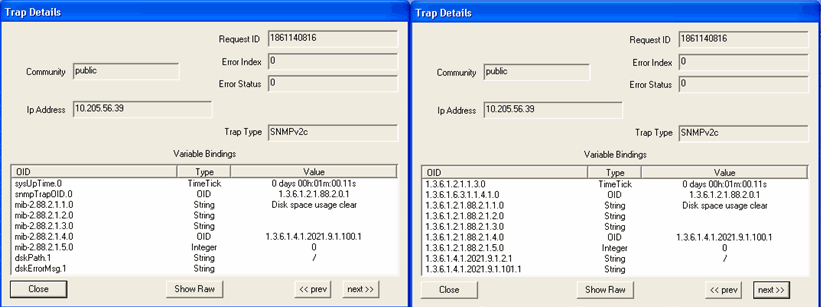 When the free disk space is less than the configured threshold, the trap shown in Figure 3 is generated. Figure 3: Disk Usage Threshold Exceeds
Configured Threshold  Figure 4 shows the OID details for the trap generated when disk usage exceeds the configured threshold. Figure 4: Trap Details When DIsk Usage
Exceeds Configured Threshold 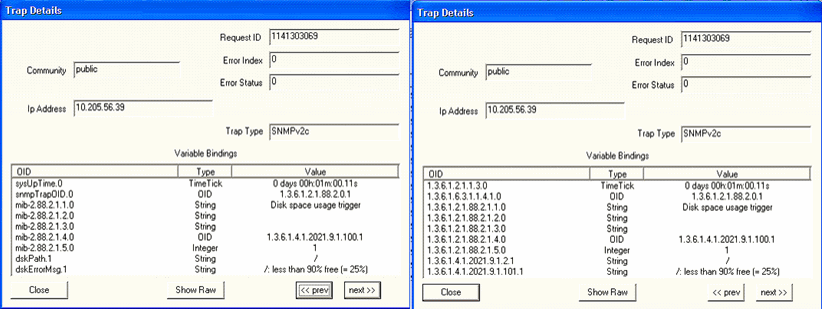 |
Table 3 shows the configuration parameters for monitoring the CPU load average.
Monitoring the CPU Load Average (System Load) |
|---|
Parameter: CPU Load (1 min, 5 min, 15 min) Default Threshold Value: 4 When the CPU Load Average threshold is less than or equal to the configured threshold limit, the trap shown in Figure 5 is generated: Figure 5: CPU Load Average Threshold Is
Normal  Figure 6 shows the OID details for the trap generated when the CPU load is normal. Figure 6: Trap Details When CPU Load
Average Threshold Is Normal 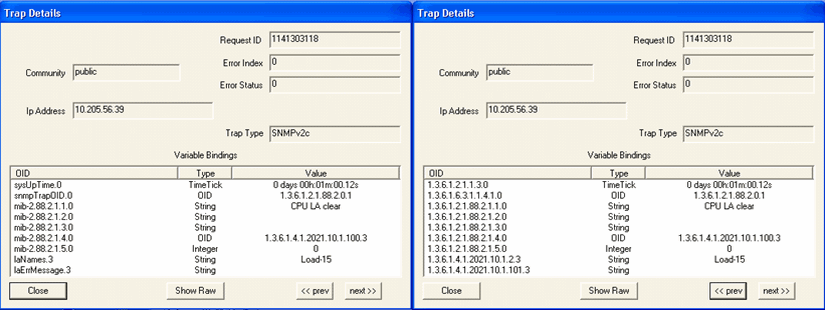 Figure 7 shows the traps generated when the 15 minute, 5 minute, or 1 minute CPU Load Average threshold is exceeded. Figure 7: CPU Load Average Threshold –
Upper Limit Exceeded  Figure 8 shows the OID details for the trap generated when the CPU load 5 minute average exceeds the threshold. Figure 8: Trap Details When CPU Load 5
Minute Average Exceeds Threshold 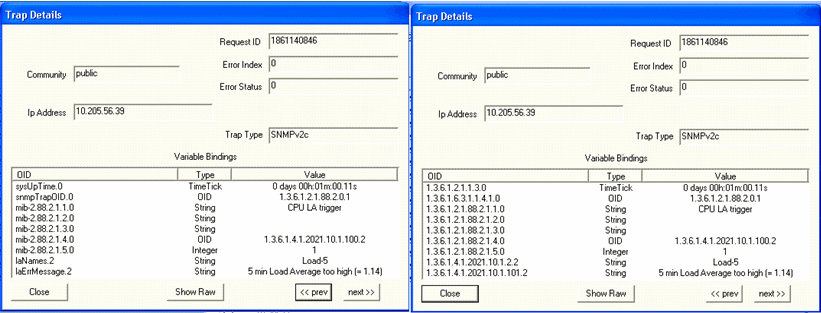 |
Table 4 shows monitoring processes for the Junos Space Network Management Platform.
Monitoring Processes |
|---|
Parameter: Node Management Agent (NMA) When the NMA process is up, the trap shown in Figure 9 is generated: Figure 9: NMA Is Up  Figure 10 shows the OID details for the trap generated when the NMA process is up. Figure 10: Trap Details When NMA Is Up 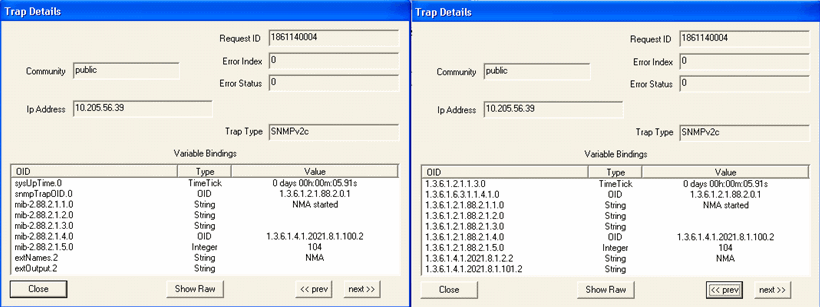 When the NMA process is down, the trap shown in Figure 11 is generated: Figure 11: NMA is Down  Figure 12 shows the OID details for the trap generated when the NMA process is down. Figure 12: Trap Details When NMA is Down 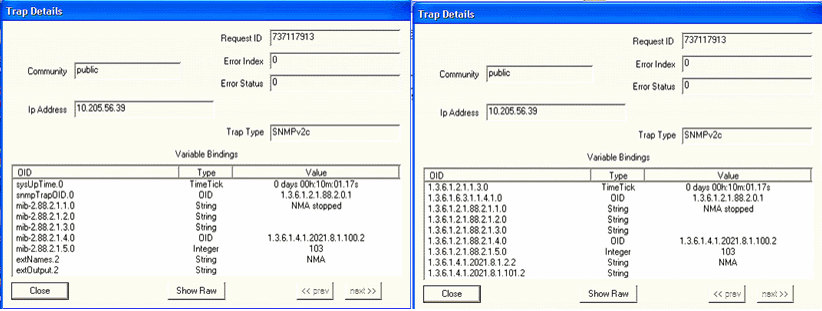 |
Parameter: Webproxy When the WebProxy process is up, the trap shown in Figure 13 is generated: Figure 13: WebProxy Is Up  Figure 14 shows the OID details for the trap generated when the WebProxy process is up. Figure 14: Trap Details When WebProxy Is
Up  When the WebProxy process is down, the trap shown in Figure 15 is generated: Figure 15: WebProxy Is Down  Figure 16 shows the OID details for the trap generated when the WebProxy is down. Figure 16: Trap Details When WebProxy
Is Down 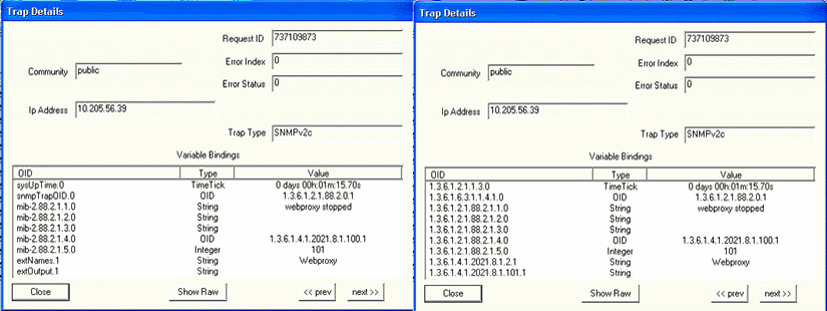 |
Parameter: JBoss When the JBoss process is up, the trap shown in Figure 17 is generated: Figure 17: JBoss Is Up  Figure 18 shows the OID details for the trap generated when the JBoss process is up. Figure 18: Trap Details When JBoss Is Up  When the JBoss process is down, the trap shown in Figure 19 is generated: Figure 19: JBoss Is Down  Figure 20 shows the OID details for the trap generated when JBoss is down. Figure 20: Trap Details When JBoss Is Down 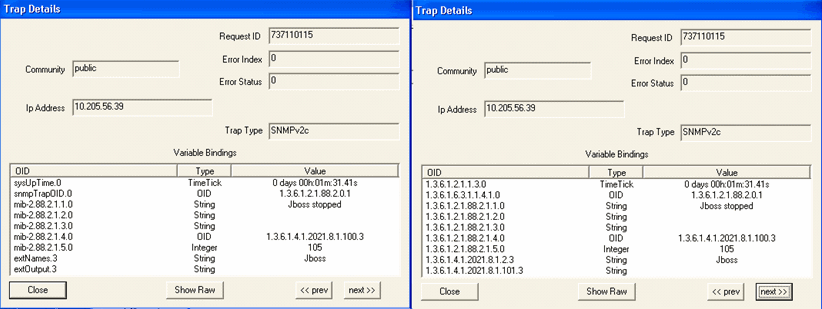 |
Parameter: Mysql When the Mysql process is up, the trap shown in Figure 21 is generated: Figure 21: Mysql Is Up  Figure 22 shows the OID details for the trap generated when the Mysql process is up. Figure 22: Trap Details When Mysql Is Up 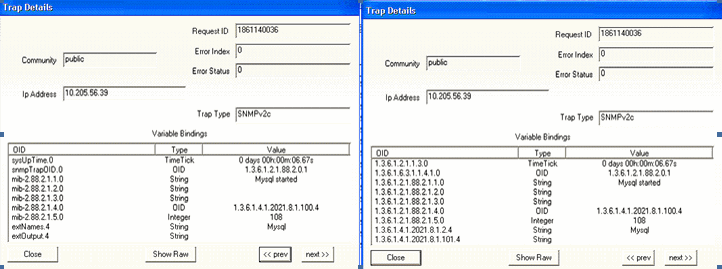 When the Mysql process is down, the trap shown in Figure 23 is generated: Figure 23: Mysql Is Down  Figure 24 shows the OID details for the trap generated when the Mysql process is down. Figure 24: Trap Details When Mysql Is Down 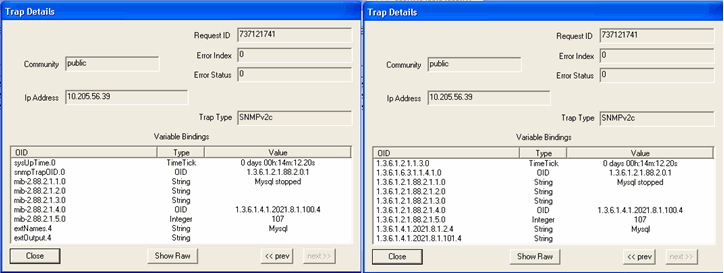 |
Parameter: Postgresql When the Postgresql process is up, the trap shown in Figure 25 is generated: Figure 25: Postgresql Is Up  Figure 26 shows the OID details for the trap generated when the Postgresql process is up. Figure 26: Trap Details When Postgresql
Is Up 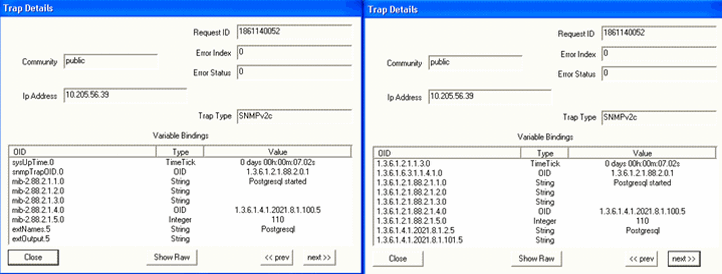 When the Postgresql process is down, the trap shown in Figure 27 is generated: Figure 27: Postgresql Is Down  Figure 28 shows the OID details for the trap generated when the Postgresql process is up. Figure 28: Trap Details When Postgresql
Is Down 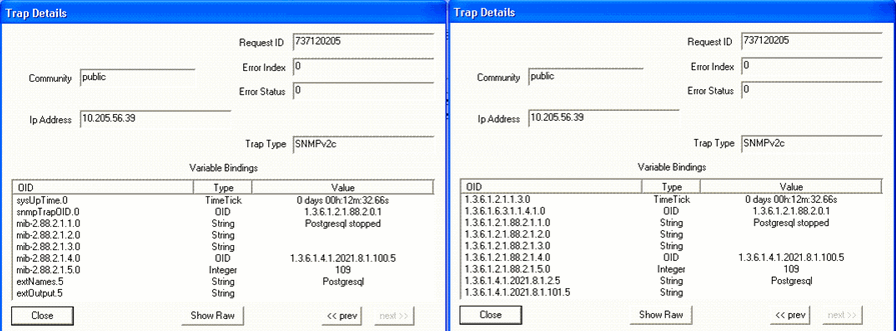 |
Parameter: Free swap memory When the free swap memory is greater than the upper threshold limit, the trap shown in Figure 29 is generated: Figure 29: Swap Memory Usage Is Normal  Figure 30 shows the OID details for the trap generated when swap memory usage is normal. Figure 30: Trap Details When Swap
Memory Is Normal 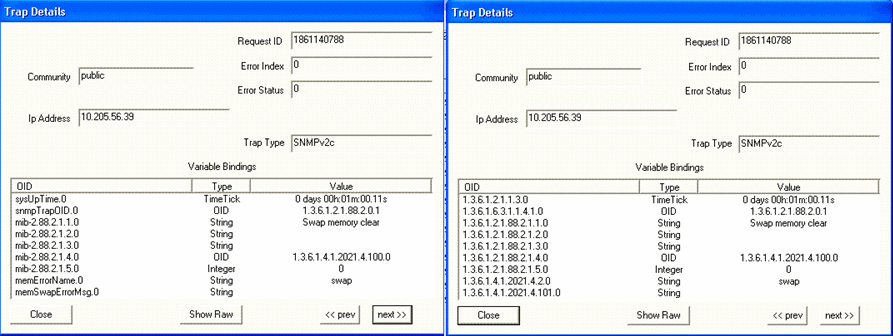 When the free swap memory is less than the upper threshold limit, the trap shown in Figure 31 is generated: Figure 31: Swap Memory Usage Threshold Exceeds
Upper Limit  Figure 32 shows the OID details for the trap generated when swap memory usage is exceeds upper limit. Figure 32: Trap Details When Swap
Memory Usage Exceeds Upper Limit 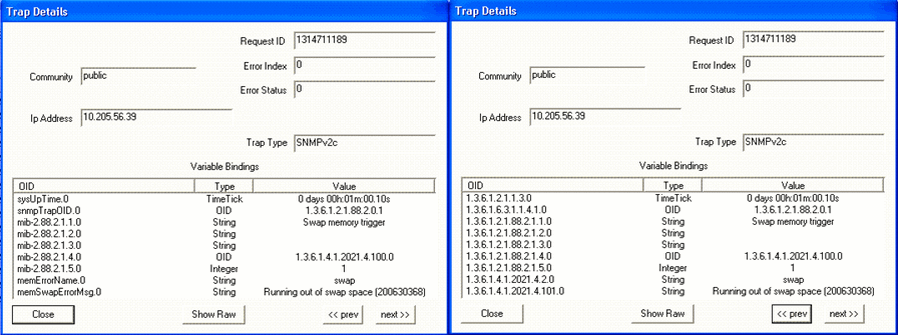 |
Table 5 shows the configuration parameters for monitoring Junos Space Network Management Platform hardware.
Monitoring Linux Hardware |
|---|
Note: LM-SENSORS-MIB is not supported by the Junos Space Virtual Appliance, but only by the Junos Space Appliance. Therefore the threshold settings of CPU Max Temp (mC), CPU Min Fan (RPM) and CPU Min Voltage (mV) will not trigger any traps in the virtual appliance. |
Parameter: CPU min FAN (rpm) Default Threshold Value: 1500 When the CPU fan speed is greater than the configured threshold (minimum fan speed), the trap shown in Figure 33 is generated: Figure 33: CPU Fan Speed Normal  Figure 34 shows the OID details for the trap generated when CPU fan speed is normal. Figure 34: Trap Details When CPU Fan Speed
Is Normal 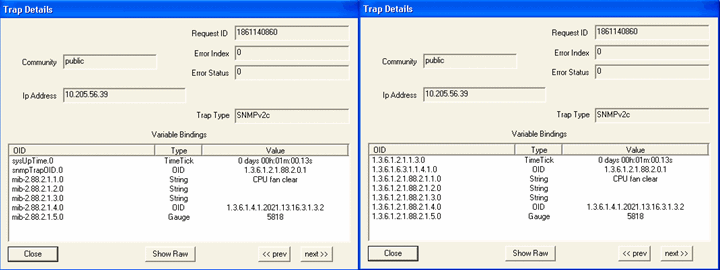 When the CPU fan speed is less than the configured threshold (minimum fan speed), the trap shown in Figure 35 is generated: Figure 35: CPU Fan Speed Is Below the Configured
Threshold  Figure 36 shows the OID details for the trap generated when CPU fan speed lower than the configured threshold. Figure 36: Trap Details When CPU Fan Speed
Is Below the Configured Threshold 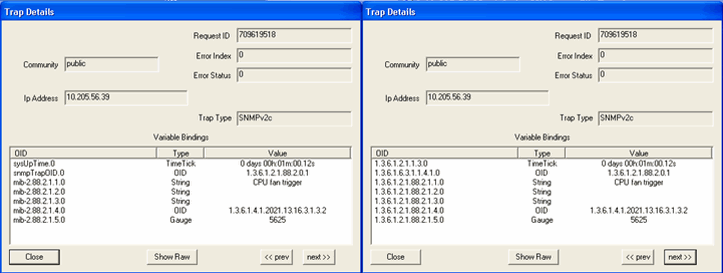 |
Parameter: CPU min Voltage (mV) When the CPU voltage is greater than the configured value, the trap shown in Figure 37 is generated: Figure 37: CPU Voltage Normal  Figure 38 shows the OID details for the trap generated when CPU voltage is normal. Figure 38: Trap Details When CPU Voltage
Is Normal 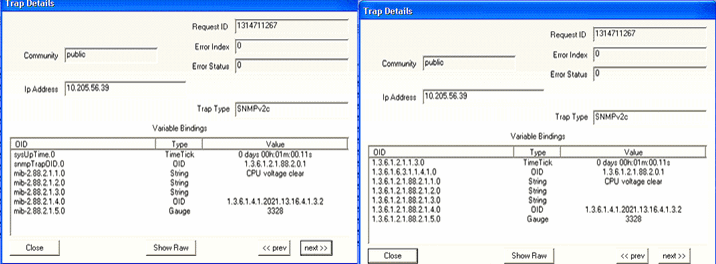 Default Threshold Value: 1000 When the CPU voltage is lower than the configured value, the trap shown in Figure 39 is generated: Figure 39: CPU Voltage Is Lower Than Configured
Threshold  Figure 40 shows the OID details for the trap generated when CPU voltage is lower than the configured threshold. Figure 40: Trap Details When CPU Voltage
Is Lower Than Configured Threshold 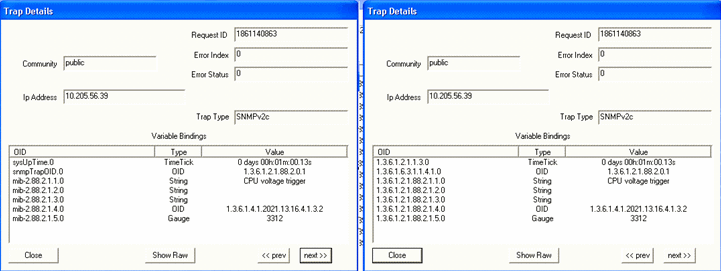 |
Parameter: CPU Temperature When the CPU temperature is lower than the configured threshold, the trap shown in Figure 41 is generated: Figure 41: CPU Temperature Normal  Figure 42 shows the OID details for the trap generated when CPU temperature is normal. Figure 42: Trap Details When CPU Temperature
Is Normal 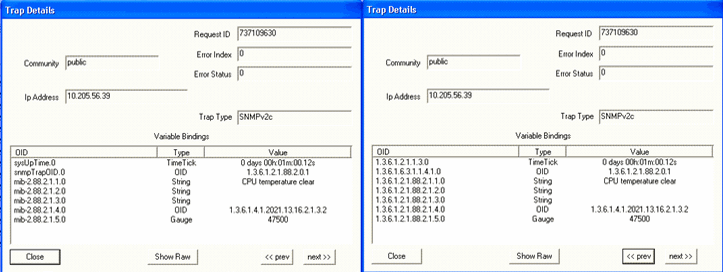 When the CPU temperature exceeds the configured threshold, the trap shown in Figure 43 is generated: Figure 43: CPU Temperature Exceeds The Configured
Threshold  Figure 44 shows the OID details for the trap generated when CPU temperature is higher than the configured threshold. Figure 44: Trap Details When CPU Temperature
Exceeds The Configured Threshold 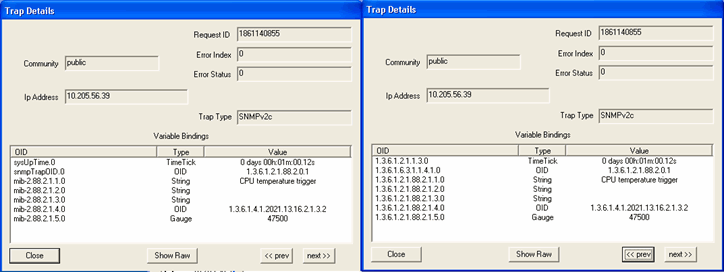 |
Table 6 shows the configuration parameters for monitoring fabric health.
| Monitoring Fabric Health |
Parameter: Junos Space Node When a Junos Space node is up, the trap shown in Figure 45 is generated: Figure 45: Junos Space Node is Up  Figure 46 shows the OID details for the trap generated when a Junos Space node is up. Figure 46: Trap Details When Junos Space
Node Is Up 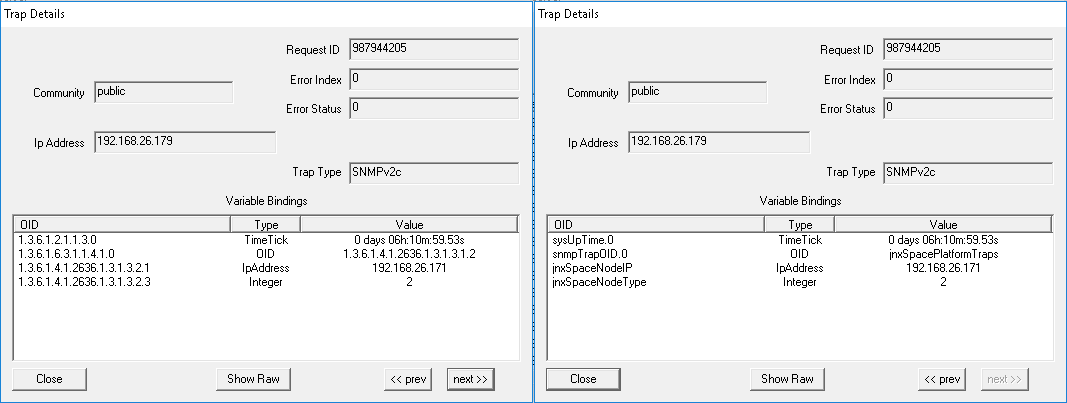 When a Junos Space node is down, the trap shown in Figure 47 is generated: Figure 47: Junos Space Node is Down  Figure 48 shows the OID details for the trap generated when a Junos Space node is down. Figure 48: Trap Details When Junos
Space Node is Down 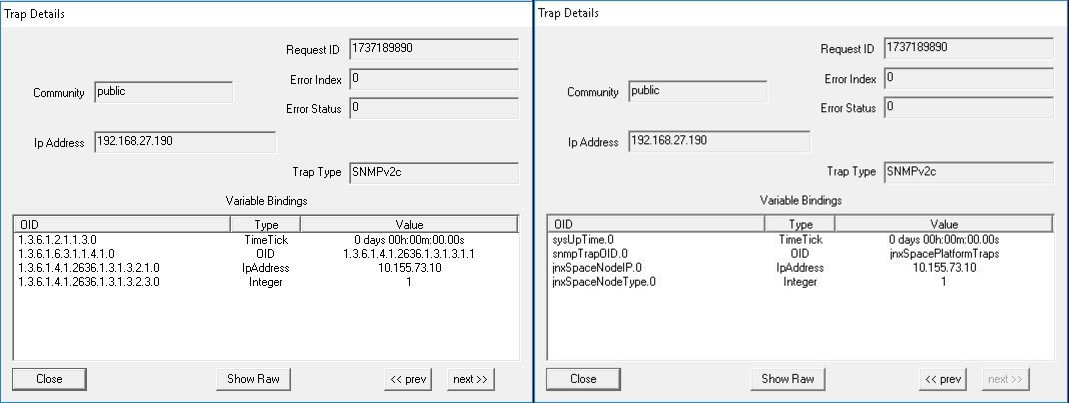 |
Parameter: Junos Space Node Removal When a Junos Space node is removed from the fabric, the trap shown in Figure 49 is generated: Figure 49: Junos Space Node Is Removed  Figure 50 shows the OID details for the trap generated when a Junos Space node is removed.. Figure 50: Trap Details When Junos
Space Node Is Removed 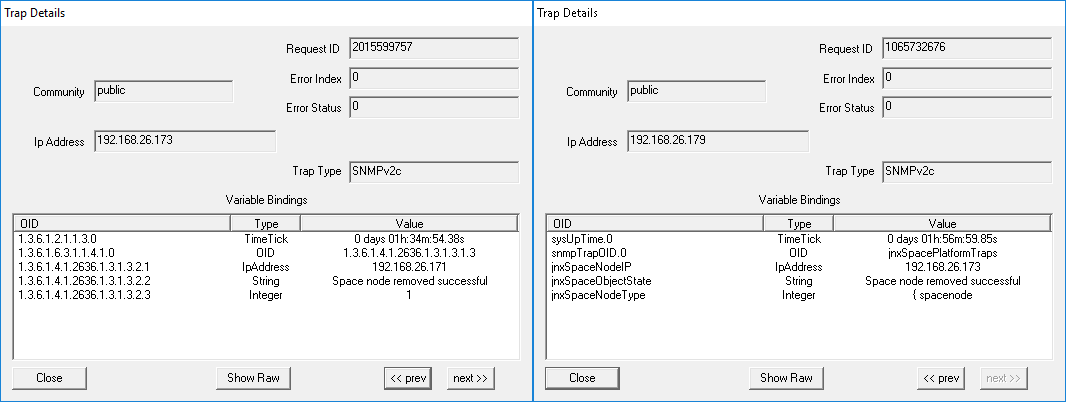 |
Parameter: JBoss Multi-Primary Detected When there is more than one JBoss AppLogic primary node detected in the cluster, the trap shown in Figure 51 is generated: Figure 51: JBoss Multi-Primary Detected  Figure 52 shows the OID details for the trap generated when there is more than one JBoss AppLogic primary node detected in the cluster. Figure 52: Trap
Details When JBoss Multi-Primary Is Detected 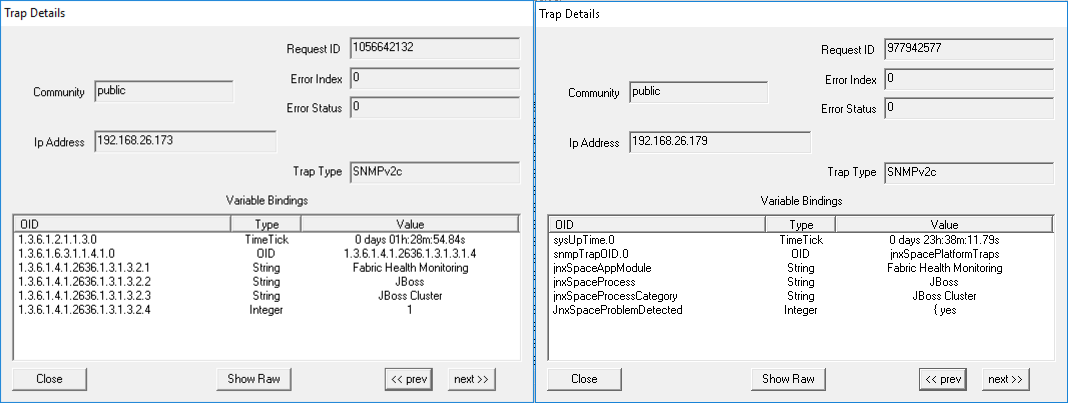 |
Parameter: VIP Bind Issue Detected in JBoss Node(s) When VIP Bind issue is detected in JBoss node(s), the trap shown in Figure 53 is generated: Figure 53: VIP Bind Issue Detected In
JBoss Node(s)  Figure 54 shows the OID details for the trap generated when VIP Bind issue is detected in JBoss node(s). Figure 54: Trap Details When VIP Bind Issue
Is Detected In JBoss Node(s) 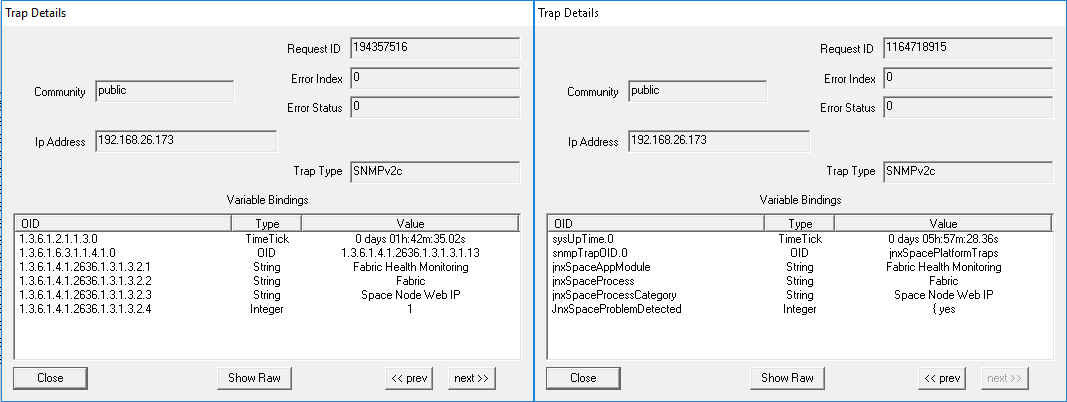 |
Parameter: Fabric Monitoring Process Inactive When fabric monitoring process is inactive, the trap shown in Figure 55 is generated: Figure 55: Fabric Monitoring Process Inactive  Figure 56 shows the OID details for the trap generated when fabric monitoring process is inactive. Figure 56: Trap Details When Fabric
Monitoring Process Is Inactive  |
Parameter: Tables Exceed Size Limit When one or more tables in the MySQL database exceed the size limit of 10 GB, the trap shown in Figure 57 is generated: Figure 57: Tables Exceed Size Limit  Figure 58 shows the OID details for the trap generated when one or more tables in the MySQL database exceed the size limit of 10 GB. Figure 58: Trap Details When Tables Exceed
Size Limit 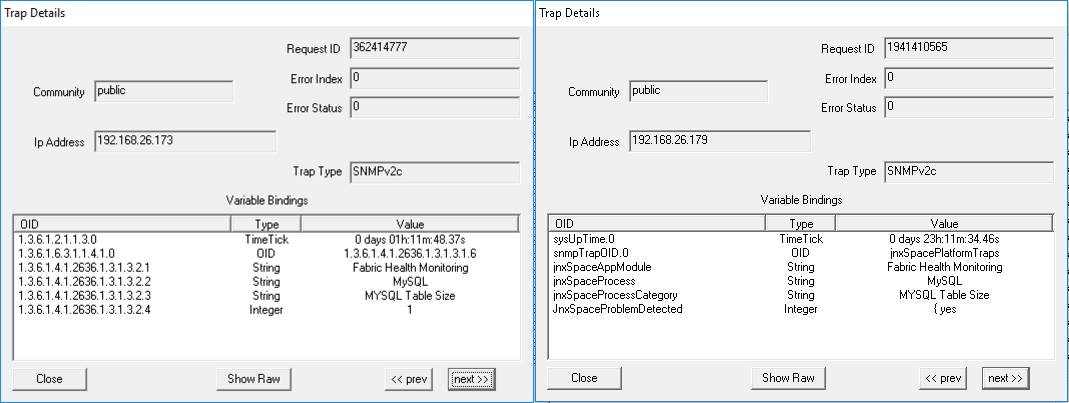 |
Parameter: Device Session Count Exceeds Threshold Limit When the device session count exceeds the threshold limit, the trap shown in Figure 59 is generated: Figure 59: Device Session Count Exceeds Threshold
Limit  Figure 60 shows the OID details for the trap generated when the device session count exceeds the threshold limit. Figure 60: Trap Details When Device Session
Count Exceeds Threshold Limit 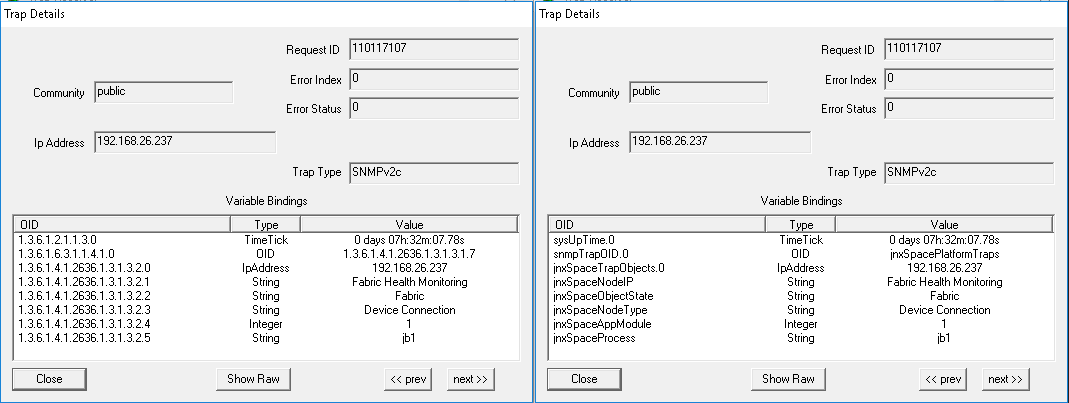 |
Parameter: HPROF Availability When Heap and CPU Profiling Agent (HPROF) files are detected on a Junos Space node, the trap shown in Figure 61 is generated: Figure 61: HPROF Availability  Figure 62 shows the OID details for the trap generated when HPROF files are detected on a Junos Space node. Figure 62: Trap Details When HPROF Files Are Available 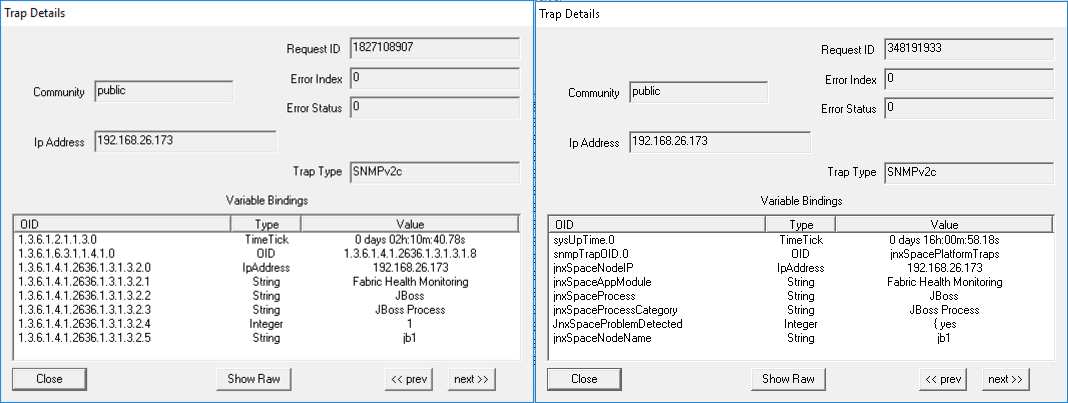 |
Parameter: JGroup Membership Issue Detected When the removal of a JBoss node from JGroup is detected in the cluster, the trap shown in Figure 63 is generated: Figure 63: JGroup Membership Issue Detected  Figure 64 shows the OID details for the trap generated when the removal of a JBoss node from JGroup is detected in the cluster. Figure 64: Trap Details When JGroup Membership
Issue Detected  |
Parameter: MySQL In Out Of Sync State When a MySQL database synchronization issue is detected between nodes running the MySQL database, the trap shown in Figure 65 is generated: Figure 65: MySQL In Out Of Sync State  Figure 66 shows the OID details for the trap generated when a MySQL database synchronization issue is detected between nodes running the MySQL database. Figure 66: Trap Details When MySQL Is In
Out Of Sync State 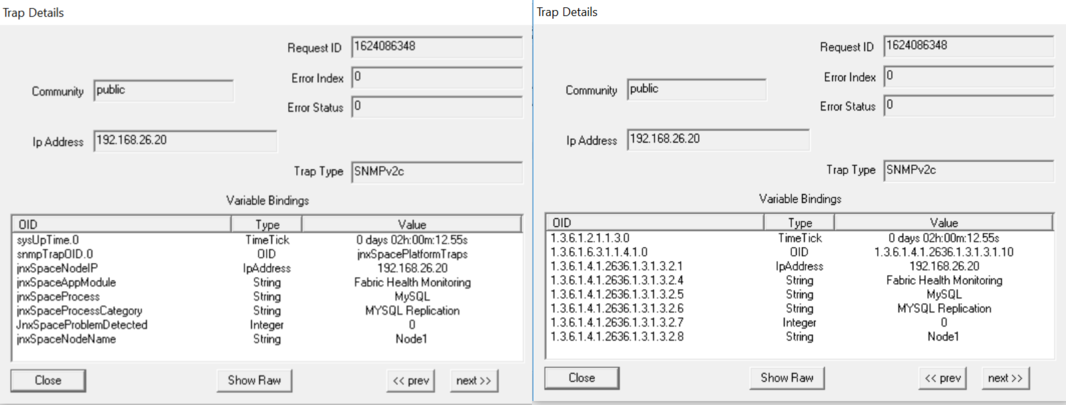 |
Parameter: File Intrusion Detection Monitoring When changes in files or file permissions are detected, the trap shown in Figure 67 is generated. Figure 67: File Intrusion Detection Monitoring  Figure 68 shows the OID details for the trap generated when file or file permission changes are detected in the system. Figure 68: Trap Details for File Intrusion
Detection Monitoring 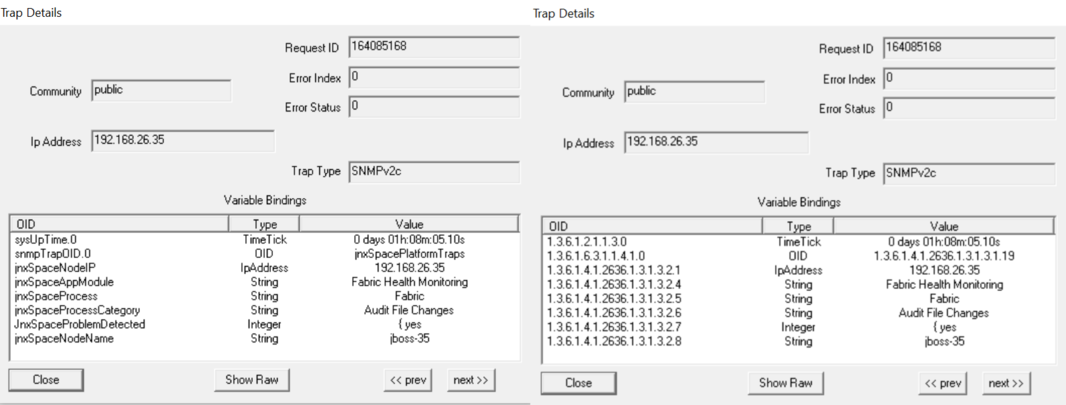 |
Parameter: Audit Logs Forwarding Failed When the system fails to forward audit logs to the configured system log server, the trap shown in Figure 69 is generated: Figure 69: Audit Logs Forwarding Failed  Figure 70 shows the OID details for the trap generated when the system fails to forward audit logs to the configured system log server. Figure 70: Trap Details When Audit Logs
Forwarding Fails 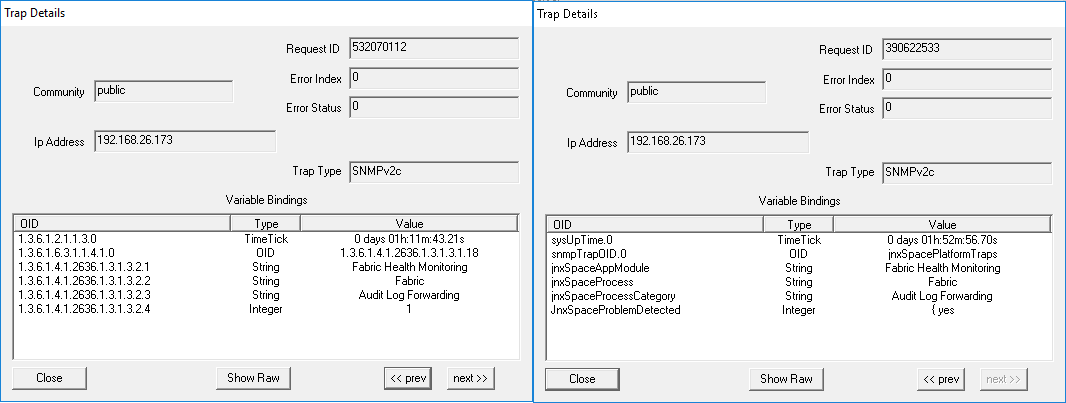 |
Parameter: One Or More Expected Process Are Inactive Junos Space monitors critical process like JBoss. If any of these expected processes are inactive, the trap shown in Figure 71 is generated: Figure 71: One or More Expected Processes Are Inactive  Figure 72 shows the OID details for the trap generated when one or more expected processes are inactive. Figure 72: Trap Details When One or More Expected
Processes Are Inactive 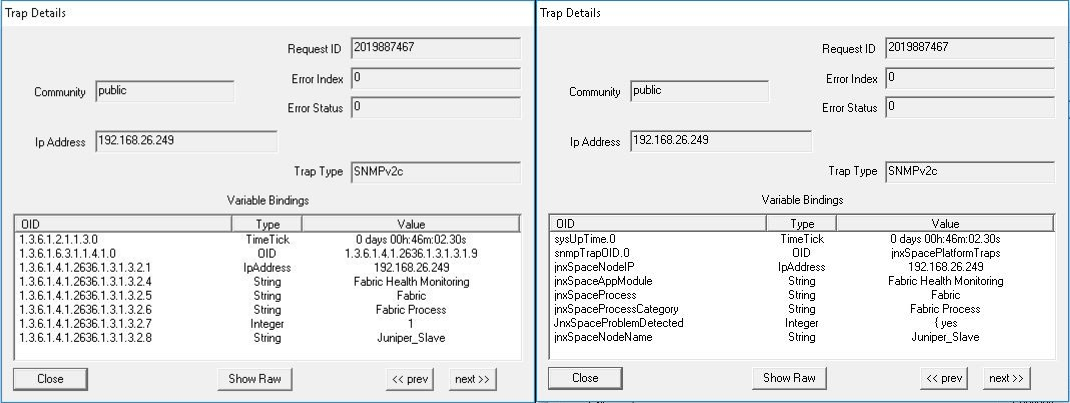 |
LM-SENSORS-MIB is not supported by the Junos Space virtual appliance, but only by the Junos Space Appliance. Therefore the threshold settings of CPU Max Temp (mC), CPU Min Fan (RPM) and CPU Min Voltage (mV) will not trigger any traps in the virtual appliance.
Junos Space supports RAID-related traps on a Junos Space appliance. The following is a sample trap:
40948 Normal [+] [-] 2/4/13 09:54:14 [<] [>] space-node 10.205.56.38 [+] [-] uei.opennms.org/generic/traps/EnterpriseDefault [+] [-] Edit notifications for event Received unformatted enterprise event (enterprise:.1.3.6.1.4.1.8072.4 generic:6 specific:1001). 1 args: .1.3.6.1.4.1.795.14.1.9000.1="One or more logical devices contain a bad stripe: controller 1."
Adding a Third-Party SNMP V1 or V2c Manager on a Fabric Node
To add a third-party SNMP V1 or V2c manager on a fabric node:
Adding a Third-Party SNMP V3 Manager on a Fabric Node
To add a third-party SNMP V3 manager on a fabric node:
The trap settings for the SNMPv3 manager are not automatically updated in Network Monitoring. Therefore, to ensure that the Network Monitoring receives the traps from Junos Space, you must add the same settings manually in the /opt/opennms/etc/trapd-configuration.xml file. Table 7 displays the mapping between the parameters in the /opt/opennms/etc/trapd-configuration.xml file and the fields in the Add 3rd Party SNMP Manager page.
The following is a sample configuration in the /opt/opennms/etc/trapd-configuration.xml file.
<?xml version="1.0"?>
<trapd-configuration snmp-trap-port="162" new-suspect-on-trap="false">
<snmpv3-user security-name="JunosSpace" auth-passphrase="auth-password" auth-protocol="MD5"/>
<snmpv3-user security-name="JunosSpace" auth-passphrase="auth-password" auth-protocol="MD5"
privacy-passphrase="privacy-password" privacy-protocol="DES"/>
</trapd-configuration>Parameter in trapd-configuration.xml File | Field in Add 3rd Party SNMP Manager Page |
|---|---|
| User Name |
| Authentication Password |
| Privacy Password |
| Privacy Type |






















